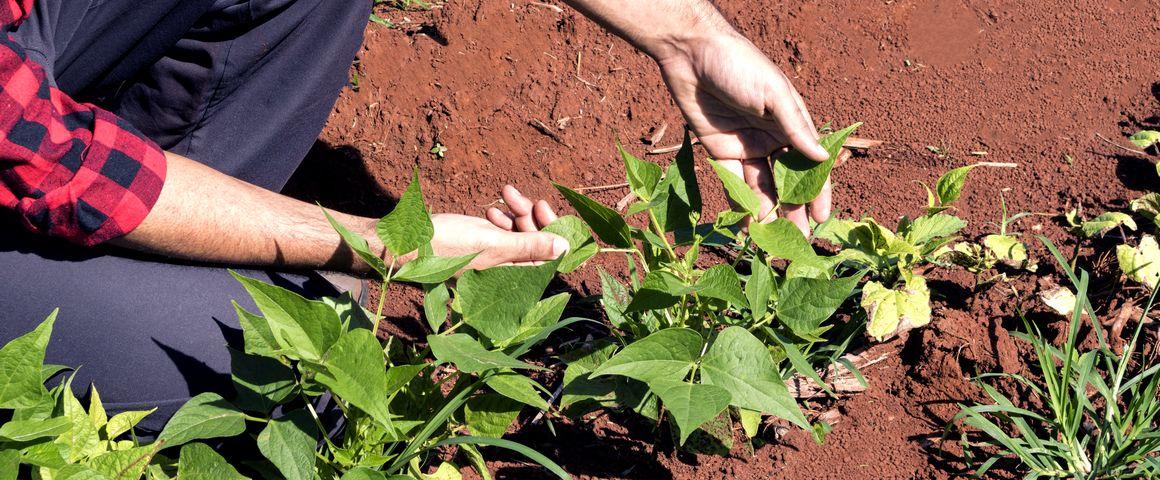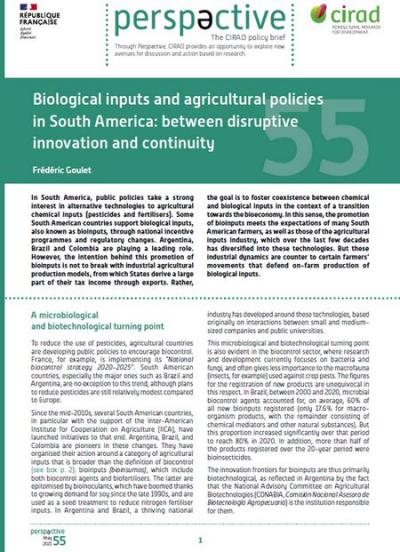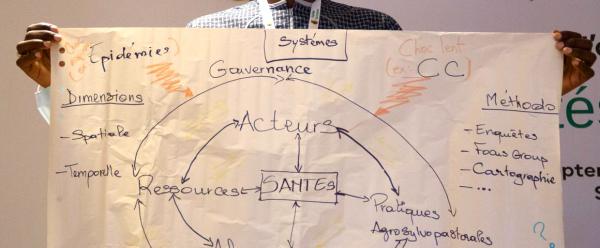Just out 3 November 2025
- Home
- CIRAD news
- News
- Perspective N°55 - Biological inputs in South America
Biological inputs are booming in South America

Biological inputs, or bioinputs, include both biofertilizers and pest and disease biocontrol products © Adobe Stock
In Latin America, public policies are increasingly designed to encourage the use of alternatives to agrochemicals (pesticides and fertilisers). However, this promotion of biological inputs, or bioinputs, does not break with industrial agricultural production models. Instead, the states are seeking to foster coexistence between chemical and biological inputs in the context of a transition towards the bioeconomy.
A microbiological and biotechnological turning point
Bioinputs include both biocontrol products and biofertilisers (see box). The latter are epitomised by bioinoculants, which have boomed thanks to growing demand for soy since the late 1990s. In Argentina and Brazil, a thriving national industry has developed around these technologies.
This microbiological and biotechnological turning point is also evident in the biocontrol sector, where research and development currently focuses on bacteria and fungi. In Brazil, 80 % of new bioinputs registered are .
Agrochemicals and bioinputs: alliances and continuity
Multinational agrochemical companies have invested in the bioinputs sector through numerous buyouts of national companies. They are thereby establishing themselves on this emerging technology frontier, enjoying high growth on the South American markets.
This industrial development of biological inputs places them in a kind of continuity, or at least coexistence, with the dominant chemical model. Moreover, South American public policies promote this vision of a very progressive transition: biological inputs are a future solution that can nevertheless complement chemical inputs in the short and medium terms.
Public policies and biological inputs
Policies on bioinputs are moving into different fields of action. The most important is perhaps that of regulatory frameworks for the assessment and approval of products. Colombia is the only country with specific legislation on biological inputs, while Argentina and Brazil have both recently developed a national programme to promote bioinputs.
But farmers’ groups are a step ahead of public action with the on-farm production of bioinputs. Brazil is a frontrunner in this dynamic.
On-farm production of bioinputs is a step ahead of public action
Since the mid-2010s, a network of large farms, both conventional and organic, has been formed at the federal level to encourage the on-farm production of micro-organisms for fertilisation or plant health: the Sustainable Agriculture Associate Group (GAAS, Grupo Asociado de Agricultura Sustentável). These farmers are recruiting microbiologist engineers and are assisted by scientists.
Industries are condemning biopiracy
These dynamics pose certain problems for the state and for the booming bioinputs industries. The state, through the National Bioinputs Programme, is striving to develop training, monitoring and control tools to manage the public heath aspects of these innovative practices.
Industries want to guarantee the intellectual property of their microbial strains and are exerting pressure to prohibit the on-farm reproduction of micro-organisms derived from their commercial products, a practice they consider to be “biopiracy”.
In France and Europe, this momentum in the on-farm production of micro-organisms is currently lacking, or almost non-existent. But there is growing interest in biocontrol, for agroecology as well as for the reappropriation by farmers of certain activities in the design and use of technologies. Close attention must therefore be paid to current innovations in South America and to the way in which they are renewing relations between farmers, agricultural research and the inputs industry.
Biocontrol refers to a set of biological techniques used to control plant pests (micro-organisms, insects, mites, nematodes, etc.). Biological control agents are divided into four main categories:
> invertebrate beneficial macro-organisms, such as insects and mites;
> micro-organisms (fungi, bacteria, viruses);
> chemical mediators, especially including insect pheromones;
> natural substances from plants, animals or minerals.
Biofertilisers are used to increase soil fertility. They can contain organic materials (manure, plant residues, compost), or micro-organisms, like bioinoculants.
Bioinoculants are products mainly containing nitrogen-fixing bacteria selected and improved in laboratories. These bacteria live naturally in symbiosis with the roots of legumes (such as soy, chickpeas and beans), capturing the chemical elements in the air and soil and returning then in a form that the plant can assimilate.
These biological inputs used in agriculture are more generally known as bioinputs (bioinsumos) in South America.
Perspective
With Perspective, CIRAD sets out to suggest new lines of debate and action, backed up by research work, albeit without presenting an official institutional position.
This series of 4-page summaries presents novel ideas or policies on development issues of strategic importance for countries in the South: food security, land tenure, climate change, energy security, forest management, standards, etc.




























